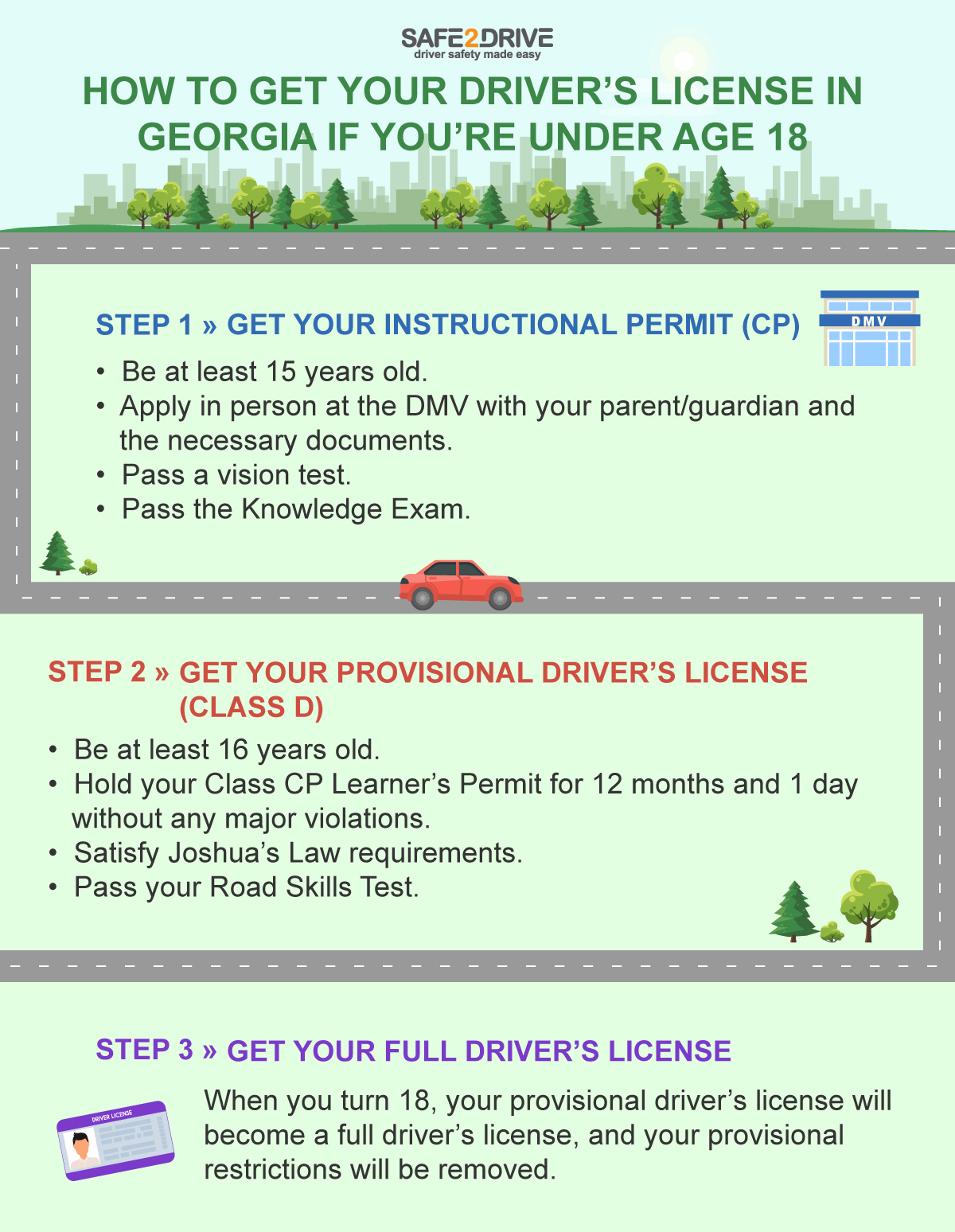
Intro
The process of earning your driver's license will depend on several factors, including your age and how long you've lived in Georgia.
The GDL Program
Graduated Driver Licensing (GDL) programs are designed to help young novice or new drivers adjust to the responsibility of obtaining full driving privileges. Studies have shown that GDL programs help reduce collisions among novice drivers. Georgia follows the Teenage & Adult Driver Responsibility Act (TADRA), which is a three-step graduated driver licensing program for drivers ages 15 to 18.
 Georgia GDL Program
Georgia GDL Program
Instructional Permit
The first stage is the Instructional Permit. You must be at least age 15 to earn your instructional permit. In order to receive your instructional permit, you have to:
- Complete a driver's license form, which must be signed by a parent, guardian, Responsible Adult, or Authorized Driver Training Instructor if the applicant is under age 18. Note: the person who signed the form may request that your license be revoked at any time before you turn age 18.
- Provide the DMV with documents proving your identity and your residency in Georgia.
- Provide current Certificate of Enrollment from school (if under age 18) completed and dated within the past six months, and other school documents.
- Make an appointment and visit a DMV office in person to go through the application process.
At your visit, you will pay an application fee, take the vision exam, get your photo taken, and complete the knowledge test. If you fail the knowledge test, you'll have to pay an additional fee for each additional attempt.
There are some restrictions that come with your instructional permit. You can only drive a regular vehicle when accompanied by a licensed driver who is at least age 21 and fit and capable of taking control of the vehicle. They must be seated in the seat beside the driver.
Provisional License
The second step in the GDL program is the provisional license. The provisional license is given to drivers between age 16 and 18 who have held an instructional permit for one year and one day, passed a road test, and met the requirements of Joshua's Law.
Joshua's Law states that if you're age 16, you must complete an approved driver education course and behind-the-wheel instruction. You can attend a certified driver's education course or complete a 30-hour online course. Safe2Drive's Online Georgia Driver Education course meets this requirement. Your parent of guardian must sign an affidavit stating that you've completed 40 hours of supervised driving experience, with 6 of those hours being at night. Those age 17+ are not required to complete a driver's education course, but are still required to complete 40 hours of supervised driving, with 6 hours being at night.
Those age 16 and age 17 must submit proof that they've completed the Alcohol and Drug Awareness Program before they can earn their provisional license.
A person with a provisional license cannot drive between the hours of midnight and 5 a.m. For the first six months of holding this license, the driver can only transport immediate family members. During the second six months of holding this license, the driver is allowed to have only one passenger under 21 years of age who is not an immediate family member ride in the vehicle. After the first year, the driver is permitted to have only three passengers under age 21 who are not immediate family members ride in the vehicle.
Full Driving Privileges
The final stage is full driving privileges (i.e., your Class C license). You must be at least age 18 to earn your Class C driver's license. You also must have held an instructional license (i.e., Class D license) and have not incurred any major traffic convictions during the previous 12 months.
Exams
There are several exams you may be required to complete in order to get your driver's license.
The first test is the road test. On the road test, you will drive a vehicle with an examiner in the front passenger seat who will give you instructions and keep score. You will be expected to demonstrate the following maneuvers:
- Parallel Parking: Park midway between two standards so that your car is not more than 18 inches from the curb. The standard parallel parking dimensions utilized in the driver’s license test are 22 feet in length by 10 feet in depth.
- Backing: Back your car for a distance of approximately 50 feet at a slow rate of speed as straight and as smoothly as possible. You must turn your head and look behind the vehicle while backing.
- Stop for Signs or Traffic Signals: Give the proper hand or brake signal, approach the proper lane, stop before reaching a pedestrian crosswalk, and remain stopped until all pedestrians have cleared the crosswalk on the side of the roadway you're traveling on. Move through the intersection only when it's safe.
- Turn About: Turn your car in a narrow space using two, three, or four-point turns.
- Use of Clutch: If your car has a manual transmission, you must shift smoothly and correctly.
- Approaching Corners: You must be in the proper lane and look in both directions.
- Yielding Right-of-Way: Always yield right-of-way to pedestrians, vehicle operators, and bicyclists who move into the intersection before you by stopping and remaining stopped until they have cleared the intersection.
- Turning: Move into the proper lane and signal an adequate distance before the turn.
- Passing: Always check in front of and behind your vehicle to make sure you can safely pass without interfering with other traffic.
- Following: Don't follow other cars too closely. Watch the car ahead of you. When it passes some reference point, such as a telephone pole, count “one one thousand, two one thousand.” If you pass the same spot before you are finished counting, you're following too closely.
- Maintaining Good Posture: Keep both hands on the steering wheel. Don't rest your elbow on the window and do not attempt to carry on a conversation with the examiner because they will be busy giving instructions and recording your score.
At the end of the test, the examiner will show you your score sheet and discuss the results with you. You must receive a score of 75 percent or higher in order to pass.
You'll also need to complete a knowledge test. This is a written test that requires you to answer 20 questions on signs, signals, and markers and 20 questions on road rules and traffic laws. You'll have to get 15 out of 20 questions correct for both types of questions in order to pass the test.
You'll also be required to take a vision screening test that is administered by the Customer Service Center. In order to pass the test, you have to have 20/60 in one eye, with or without corrective lenses, and a field of vision of at least 140 degrees. If you need to wear glasses or contacts to pass the test, a corrective lenses restriction will be placed on your license when it's issued. If you don't pass the test, the Customer Service Center will give you a Vision Report (form DS-274) that must be signed by a licensed optometrist or ophthalmologist that you'll need to complete and return to the DDS.
New Georgia Residents
You have an out-of-state license if you've moved to Georgia and your license was issued by one of the other 49 states, DC, or US territories. In this case, you'll have to apply for a Georgia Driver's license within 30 days of becoming a resident in Georgia. Any DDS Customer Service Center can help you transfer your out-of-state license to a Georgia license.
You will need to present documentation proving your identity, residential address, social security number, and US citizenship or lawful status in the US. You'll also need to present your current out-of-state license.
When you arrive at the DDS Customer Service center, your social security number will be verified and you'll get your photo taken. You'll also have to pay the required fees.
What to Bring to the DDS
What you need to bring with you to the DDS will depend on what type of license you are applying for. You can visit the DDS's website to see a full list of approved documents, but generally you will need:
- Proof of identity documents (e.g., a US Birth Certificate or a US Citizen Identification Card)
- Name change documentation
- Proof of residency documents (e.g., rental/lease agreement, deed/title to residential real property, employment document, or medication documents)
If you're a Georgia resident and you need to complete a driver's education course to satisfy licensing requirements, click below to learn more about Safe2Drive's Online Georgia Driver Education course!
Register for GA Driver's Ed Course